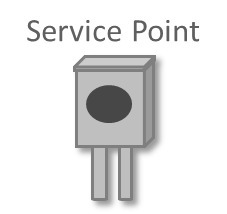About Service Points
Service points are physical locations (usually a meter socket) at which a company supplies service and are used in Oracle Utilities Meter Data Management to store information describing the type of service supplied and how it is measured. Devices are installed at service points, and the relationship between individual service points and devices can change over time. For example, over time different devices may be installed at a service point, and a device may be installed at different service points.
A service point may only have one device. If multiple devices at a service point are required, define a parent and child service point relationship to create a hierarchy of service points. On each service point, users will be able to specify a parent service point. An example of this feature would be to link each condominium in a building to a parent service point that represents the common areas of the building. Another example would be a deregulated service point that allows multiple devices per service point. In this example, the parent service point would be the market service point ID and the children service points would relate to the individual devices.

- Basic information about the Service Point, including address, time zone, market, parent Service Point (if applicable), status, and main contact
- Specifics related to whether or not the current Service Point supplies service to life support equipment, or if the load supplied to the Service Point is considered sensitive
- Information related to field work performed at the current Service Point, including any applicable warnings or instructions
- The measurement cycle, route, and route sequence for the Service Point
Service Point Access via Access Groups and Divisions
Access to service points (and objects and data related to the service point, see below) can be restricted based on Access Groups and Divisions.
Restriction via Access Groups
Service point data access restriction based on Access Group is enabled by default. Users can only access service points (and related objects and data) with an Access Group associated with the user via Access Role on the Access Security tab of the User Preferences portal. See The Big Picture of Row Security in the Administrative User Guide for more information about Access Groups and Access Roles. Restriction via Access Groups applies to all service point queries, including use of the Service Point Search zone, the Route Management and 360 Search portals, and service point queries on other zones and portals.
Restriction via Division
To enable service point data access restriction based on Division, select "Yes" from the Restrict Division drop-down list in the Control By Division section of MDM Master Configuration.
When this restriction is in effect, users can only access service points (and related objects and data) with a Division (or Divisions) associated with the user on the User Miscellaneous Information zone on the Miscellaneous tab of the User portal. This applies to all service point queries, including use of the Service Point Search zone, the Route Management and 360 Search portals, and service point queries on other zones and portals.
Unbadged Items
Items that do not have any unique identification are referred to as "unbadged." These types of items, unlike "badged" items, do not have a device to represent them. Instead they are associated to service points with the service point category of "multi-item." For these types of service points a list of "unbadged" items can be configured to represent the items that require usage to be calculated. This is an effective dated list that allows for changes over time to the type and count of items over time. The consumption of the list of items is either calculated using the service quantity associated to the item types listed or by using the installation override quantity that can be specified on the service point.
Refer to Multi Time Zone Support for additional information on the importance of the Service Point time zone.
